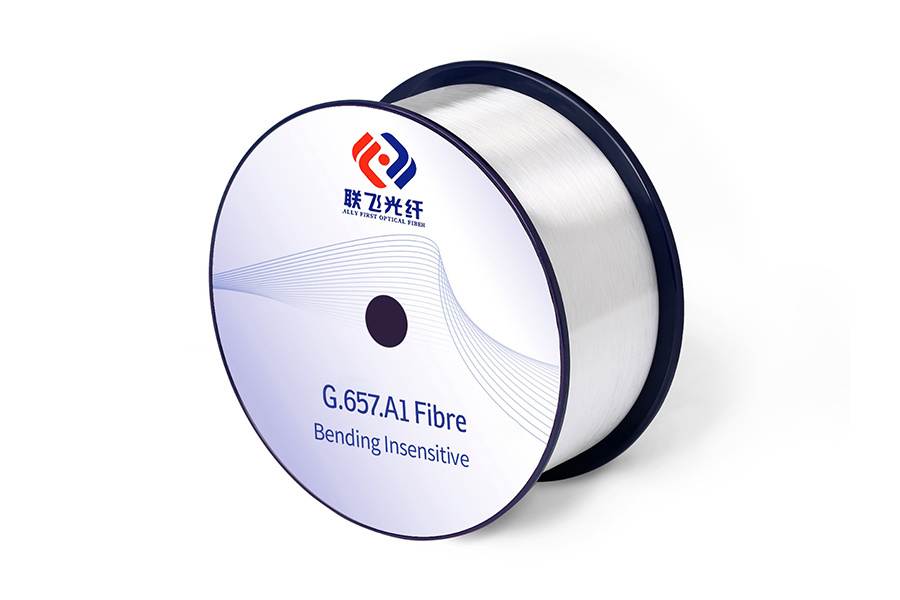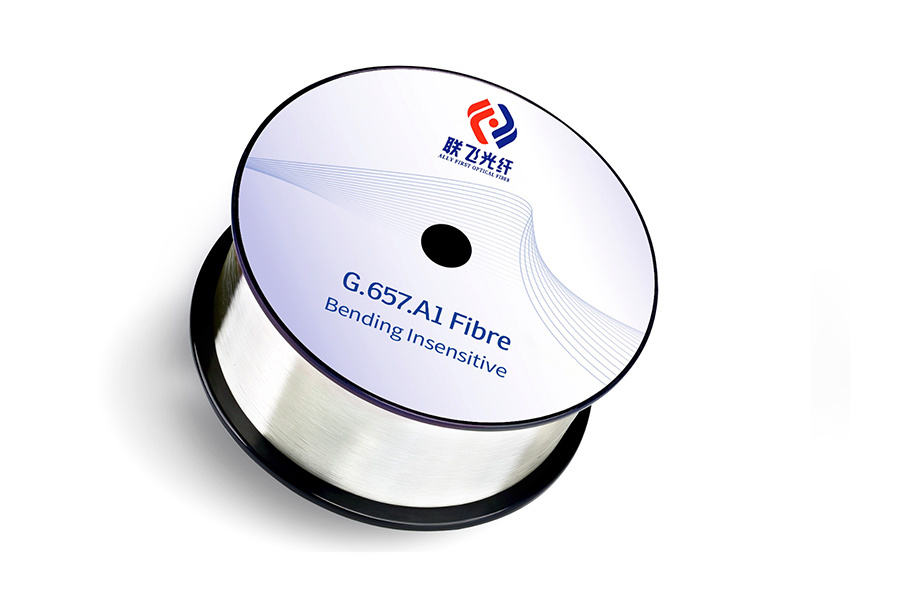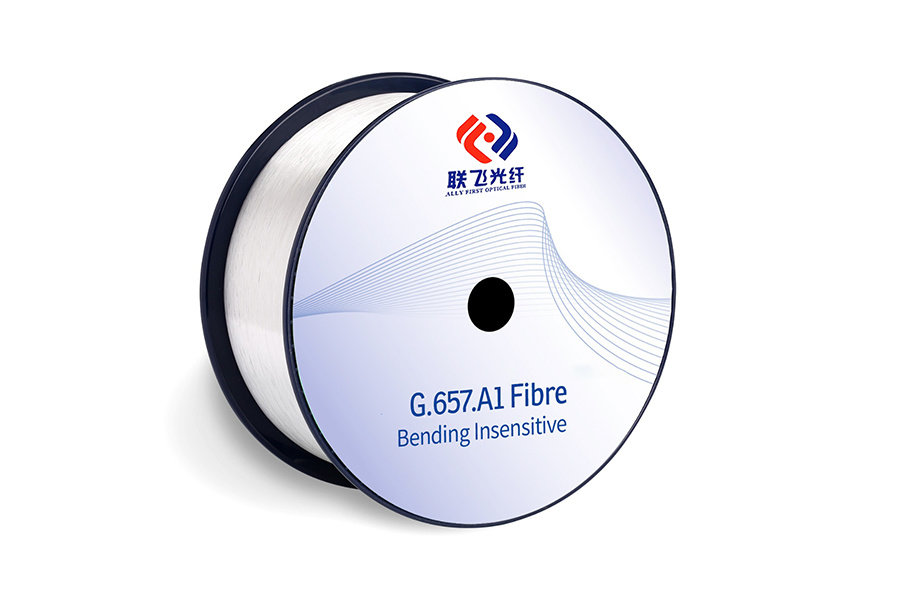Products
Bending Insensitive Single-mode Fiber
YOFC EasyBand® bending insensitive single-mode fibre encompasses all the features of FullBand® fibre and provides good resistance to maro-bending. It has low macro-bending sensitivity and low water-peak level. It is comprehensively optimized for use in O-E-S-C-L band (1260 -1625 nm). It offers good resistance to additional losses due to low macro-bending in the 1625 nm wavelength region. This not only supports L-band applications but also allows for easy installation without excessive care when storing the fibre, for example, in splicing cassettes. For cable use inside buildings, the fibre supports installation with small cable bending radii and compact organizers.
- Applications
-
• Short pitch cables for special application
• High performance optical network operating in O-E-S-C-L band
• High speed optical routes in buildings (FTTx)
• Cables with low bending requirements
- Product standards
-
Ally First Optical Fiber and Cable bending insensitive single mode fibre meets or exceeds the ITU-T Recommendation G.652.D/G.657.
A1 including the IEC 60793-2-50 type B1.3/B6.a1 Optical Fibre Specification.
- Characteristics
-
• Low attenuation satisfying the operation demand in O-E-S-C-L band
• Good bending loss resistance at short radius bends
• Low bending loss for highly demanding cable designs including ribbons
• Low PMD satisfying high bit-rate and long distance transmission requirements
• Accurate geometrical parameters that insure low splicing loss and high splicing efficiency
-
Standard length: 2,000m;other lengths are also available
Specifications
|
Characteristics |
Conditions | Specified values | Units | |
|---|---|---|---|---|
|
Optical Characteristics |
||||
|
Attenuation |
1310nm |
≤0.35 |
[dB/km] |
|
|
1383nm(after H2-aging) |
≤0.35 |
[dB/km] |
||
|
1460nm |
≤0.25 |
[dB/km] |
||
|
1550nm |
≤0.21 |
[dB/km] |
||
|
1625nm |
≤0.23 |
[dB/km] |
||
|
Attenuation vs. Wavelength Max. α difference |
1285-1330nm, in reference to 1310nm |
≤0.03 |
[dB/km] |
|
|
1525~1575nm, 相对于1550nm |
≤0.02 |
[dB/km] |
||
| Dispersion Coefficient |
1285-1340nm |
-3.5 to 3.5 |
[ps/(nm·km)] |
|
|
1550nm |
≤18 |
[ps/(nm·km)] |
||
|
1625nm |
≤22 | [ps/(nm·km)] | ||
| Zero Dispersion Wavelength(λ0) |
-- |
1300-1324 |
[ps/√km] |
|
| Zero Dispersion Slope(S0) |
-- |
≤0.092 |
[ps/√km] |
|
|
Typical Value |
-- |
0.086 |
[ps/√km] |
|
| PMD |
Maximum Individual Fibre |
-- | ≤0.1 | [nm] |
|
Link Design Value(M=20,Q=0.01%) |
-- | ≤0.06 | [nm] | |
|
Typical Value |
-- | 0.04 | [nm] | |
|
Cable Cutoff Wavelength (λCC) |
-- |
≤1260 |
[nm] |
|
|
Mode Field Diameter(MFD) |
1310nm | 8.4-9.2 |
[μm] |
|
| 1550nm | 9.3-10.3 |
[μm] |
||
|
Effective Group Index of Refraction(Neff) |
1310nm | 1.466 |
-- |
|
| 1550nm | 1.467 |
-- |
||
|
Point Discontinuities |
1310nm | ≤0.05 |
[dB] |
|
| 1550nm | ≤0.05 |
[dB] |
||
|
Geometrical Characteristics |
||||
|
Cladding Diameter |
-- |
125.0±0.7 |
[μm] |
|
|
Cladding Non-Circularity |
-- |
≤0.7 |
[%] |
|
| Coating Diameter |
-- |
235~245 |
[μm] |
|
| Coating-Cladding Concentricity Error |
-- |
≤12.0 |
[μm] |
|
| Coating Non-Circularity |
-- |
≤6.0 |
[%] |
|
|
Core-Cladding Concentricity Error |
-- |
≤0.5 |
[μm] |
|
|
Curl(radius) |
-- |
≥4 |
[m] |
|
|
Delivery Length |
-- |
Up to 50.4 |
[km/reel] |
|
|
Environmental Characteristics |
1310nm, 1550nm & 1625nm | |||
|
Temperature Dependence Induced Attenuation |
-65℃ +85℃ |
≤0.05 |
[dB/km] |
|
|
Temperature-Humidity Cycling Induced Attenuation |
-10°C to +85°C, 98% RH |
≤0.05 |
[dB/km] |
|
|
Watersoak Dependence Induced Attenuation |
23°C, for 30 days |
≤0.05 |
[dB/km] |
|
|
Damp Heat Dependence Induced Attenuation |
85°C and 85% RH, for 30 days |
≤0.05 |
[dB/km] |
|
|
Dry Heat Aging |
85℃, for 30 days |
≤0.05 |
[dB/km] |
|
|
Mechanical Specification |
||||
|
Proof Test |
-- |
≥9.0 |
[N] |
|
|
-- |
≥1.0 |
[%] |
||
|
-- |
≥100 |
[kpsi] |
||
| Macro-bend Induced Loss |
10 Turns Around a Mandrel of 15 mm Radius |
1550nm | ≤0.25 | [dB] |
| 10 Turns Around a Mandrel of 15 mm Radius |
1625nm |
≤1.0 |
[dB] |
|
| 1 Turn Around a Mandrel of 10 mm Radius |
1550nm |
≤0.75 |
[dB] |
|
| 1 Turn Around a Mandrel of 10 mm Radius |
1625nm |
≤1.5 |
[dB] |
|
|
Coating Strip Force |
typical average force |
1.5 |
[N] |
|
|
peak force |
1.3~8.9 |
[N] |
||
| Dynamic Fatigue Parameter(nd) |
-- |
≥20 |
-- |
|
- 产品描述
- 规格参数
-
- Commodity name: Bending Insensitive Single-mode Fiber
YOFC EasyBand® bending insensitive single-mode fibre encompasses all the features of FullBand® fibre and provides good resistance to maro-bending. It has low macro-bending sensitivity and low water-peak level. It is comprehensively optimized for use in O-E-S-C-L band (1260 -1625 nm). It offers good resistance to additional losses due to low macro-bending in the 1625 nm wavelength region. This not only supports L-band applications but also allows for easy installation without excessive care when storing the fibre, for example, in splicing cassettes. For cable use inside buildings, the fibre supports installation with small cable bending radii and compact organizers.
- Applications
-
• Short pitch cables for special application
• High performance optical network operating in O-E-S-C-L band
• High speed optical routes in buildings (FTTx)
• Cables with low bending requirements
- Product standards
-
Ally First Optical Fiber and Cable bending insensitive single mode fibre meets or exceeds the ITU-T Recommendation G.652.D/G.657.
A1 including the IEC 60793-2-50 type B1.3/B6.a1 Optical Fibre Specification.
- Characteristics
-
• Low attenuation satisfying the operation demand in O-E-S-C-L band
• Good bending loss resistance at short radius bends
• Low bending loss for highly demanding cable designs including ribbons
• Low PMD satisfying high bit-rate and long distance transmission requirements
• Accurate geometrical parameters that insure low splicing loss and high splicing efficiency
-
Standard length: 2,000m;other lengths are also available
-
Specifications
Characteristics
Conditions Specified values Units Optical Characteristics
Attenuation
1310nm
≤0.35
[dB/km]
1383nm(after H2-aging)
≤0.35
[dB/km]
1460nm
≤0.25
[dB/km]
1550nm
≤0.21
[dB/km]
1625nm
≤0.23
[dB/km]
Attenuation vs. Wavelength
Max. α difference
1285-1330nm, in reference to 1310nm
≤0.03
[dB/km]
1525~1575nm, 相对于1550nm
≤0.02
[dB/km]
Dispersion Coefficient 1285-1340nm
-3.5 to 3.5 [ps/(nm·km)]
1550nm
≤18 [ps/(nm·km)]
1625nm
≤22 [ps/(nm·km)] Zero Dispersion Wavelength(λ0) --
1300-1324 [ps/√km]
Zero Dispersion Slope(S0) --
≤0.092 [ps/√km]
Typical Value
--
0.086 [ps/√km]
PMD Maximum Individual Fibre
-- ≤0.1 [nm] Link Design Value(M=20,Q=0.01%)
-- ≤0.06 [nm] Typical Value
-- 0.04 [nm] Cable Cutoff Wavelength (λCC)
--
≤1260 [nm]
Mode Field Diameter(MFD)
1310nm 8.4-9.2 [μm]
1550nm 9.3-10.3 [μm]
Effective Group Index of Refraction(Neff)
1310nm 1.466 --
1550nm 1.467 --
Point Discontinuities
1310nm ≤0.05 [dB]
1550nm ≤0.05 [dB]
Geometrical Characteristics
Cladding Diameter
--
125.0±0.7
[μm]
Cladding Non-Circularity
--
≤0.7
[%]
Coating Diameter --
235~245 [μm]
Coating-Cladding Concentricity Error --
≤12.0
[μm]
Coating Non-Circularity --
≤6.0
[%]
Core-Cladding Concentricity Error
--
≤0.5
[μm]
Curl(radius)
--
≥4
[m]
Delivery Length
--
Up to 50.4 [km/reel]
Environmental Characteristics
1310nm, 1550nm & 1625nm Temperature Dependence Induced Attenuation
-65℃ +85℃
≤0.05
[dB/km]
Temperature-Humidity Cycling Induced Attenuation
-10°C to +85°C, 98% RH
≤0.05
[dB/km]
Watersoak Dependence Induced Attenuation
23°C, for 30 days
≤0.05
[dB/km]
Damp Heat Dependence Induced Attenuation
85°C and 85% RH, for 30 days
≤0.05
[dB/km]
Dry Heat Aging
85℃, for 30 days
≤0.05
[dB/km]
Mechanical Specification
Proof Test
--
≥9.0
[N]
--
≥1.0
[%]
--
≥100
[kpsi]
Macro-bend Induced Loss 10 Turns Around a Mandrel of 15 mm Radius
1550nm ≤0.25 [dB] 10 Turns Around a Mandrel of 15 mm Radius 1625nm
≤1.0
[dB]
1 Turn Around a Mandrel of 10 mm Radius 1550nm
≤0.75
[dB]
1 Turn Around a Mandrel of 10 mm Radius 1625nm
≤1.5
[dB]
Coating Strip Force
typical average force
1.5
[N]
peak force
1.3~8.9
[N]
Dynamic Fatigue Parameter(nd) --
≥20 --
Product Color Pages
Related Products








